or start from open source methods. Learn more about OneLab softwareUse OneLab
NucleoSpin Soil/Plant/Food
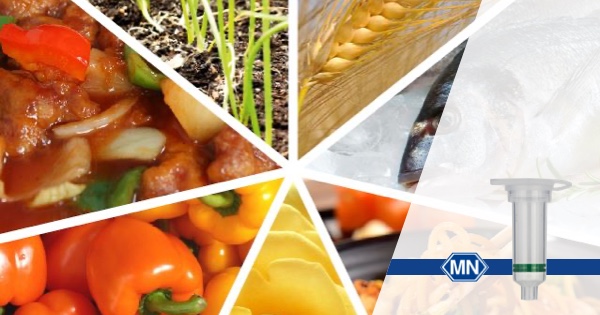
This basic method provides the core methodology for translating a workflow into OneLab-executable script(s) as an attempt to fully or semi-automate a specific procedure. It demonstrates the benefits of automation and highlights OneLab capabilities and best practices to promote solution adoption, helping transition from manual to a more automated approach. It can be used alone or serves as a building block for a more complex workflow and is easily adaptable to users' requirements.
Overview
NucleoSpin Plant II ─ Genomic DNA Extraction from Plant Tissue
As plants are very heterogeneous and contain a range of different metabolites such as polyphenols, polysaccharides, or acidic components, the NucleoSpin Plant II offers two different lysis procedures, based on CTAB and SDS lysis methods (with Lysis Buffer PL1 and PL2, respectively), for optimal processing of various samples. The silica membrane in each NucleoSpin Plant II column is optimized to improve DNA binding. NucleoSpin filters are included for convenient clarification of lysates. The eluted, purified DNA is ready to use in downstream applications, including PCR and restriction analysis.
► NucleoSpin Plant II Procedure

Figure 1: Plant samples are homogenized by mechanical treatment. Lysates are cleared with NucleoSpin Plant Filters before the isolation of genomic DNA (gDNA).
► gDNA Isolation Using NucleoSpin Plant II in Comparison to Competitors' Kits
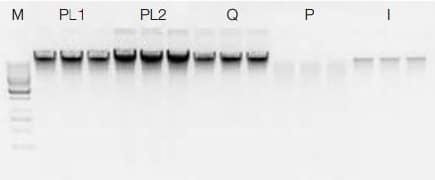
Figure 2: 100 mg of fresh fir needles (Abies alba) were processed in triplicate using the NucleoSpin Plant II kit (Lysis Buffer PL1 and PL2) and competitors' products (Q, P, and I). A 10 μL volume of each DNA eluate was analyzed on a 1% TAE-agarose gel.
NucleoSpin Soil ─ Soil DNA Isolation
Soil samples contain different amounts of organic matter and inorganic material (humic substances or polysaccharides) and exhibit different pHs, all of which can hinder the consistency of DNA extraction from these sample types. The NucleoSpin Soil kit overcomes these obstacles through the use of highly optimized lysis conditions and mechanical disruption.
► NucleoSpin Soil Procedure

Figure 3: Soil samples are homogenized with NM Bead Tubes Type A (ceramic beads). The NucleoSpin Soil kit is designed for the isolation of genomic DNA from microorganisms such as Gram-positive and Gram-negative bacteria, archaea, fungi, and algae in soil, sludge, and sediment samples.
► NucleoSpin Soil Guarantees Superior DNA Yield and Purity from Various Soil Types
Two alternative Lysis Buffers and a special additive (Enhancer SX) for optimal processing of various soil samples ⎯ optimal lysis conditions for your application.
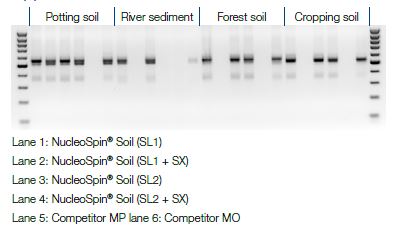
Figure 4: DNA was purified with NucleoSpin Soil using Lysis Buffers SL1 and SL2, with and without Enhancer SX, as well as with kits from competitor MP, and MO. A 2 μL volume of the undiluted eluate was used as a PCR template with fungi-specific internal transcribed spacer (ITS) primers. Competitor MP failed to yield DNA pure enough to be used undiluted. DNA yield and inhibitor concentration were both low for competitor MO, but the PCR from river sediment samples was still strongly inhibited. With NucleoSpin Soil, there were at least two conditions for each soil type yielding a large amount of DNA, and the PCR was successful with undiluted DNA.
NucleoSpin Food ─ Isolation of gDNA from Food & Feed
The NucleoSpin Food kit enables rapid isolation of genomic DNA from many types of processed food or animal feed of plant or animal origin. Food samples are highly heterogeneous and contain many different compounds such as fats and polysaccharides. These characteristics make DNA extraction challenging. The NucleoSpin Food protocol guarantees good recovery rates for small genomic DNA fragments from food.
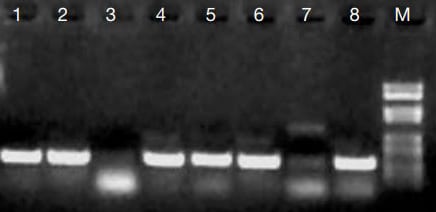
Figure 5: Beef detection in sausage products. DNA preparation was done according to the NucleoSpin Food standard protocol. Aliquots of the 100 μL eluates were amplified using primers and components of a commercial kit (CIBUS, Germany). Bovine DNA could be detected in several products, even in strongly processed samples. Sample 8 was declared to be prepared from duck meat only, but clearly showed the presence of beef. Samples 3 and 7 did not contain detectable amounts of bovine DNA.
Ordering Information ─ Kit Consumables by MACHEREY-NAGEL
- NucleoSpin Plant II ⎯ Mini spin kit for purifying genomic DNA from plants | REF: 740770.10/.50/.250
- NucleoSpin Soil ⎯ Mini spin kit for DNA isolation from soil, sludge, and sediment | REF: 740780.10/.50/.250
- NucleoSpin Food ⎯ Mini spin kit for the isolation of genomic DNA from food and feed | REF: 740945.10/.50/.250
Find more information about RNA and DNA purification from hard to lyse samples
Protocols
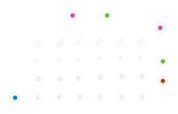
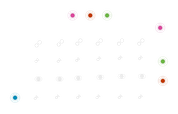

Contact info

 This is an open access protocol distributed under the terms of the Creative Commons Attribution License, which permits unrestricted use, distribution, and reproduction in any medium, provided the original author and source are credited.
This is an open access protocol distributed under the terms of the Creative Commons Attribution License, which permits unrestricted use, distribution, and reproduction in any medium, provided the original author and source are credited. 